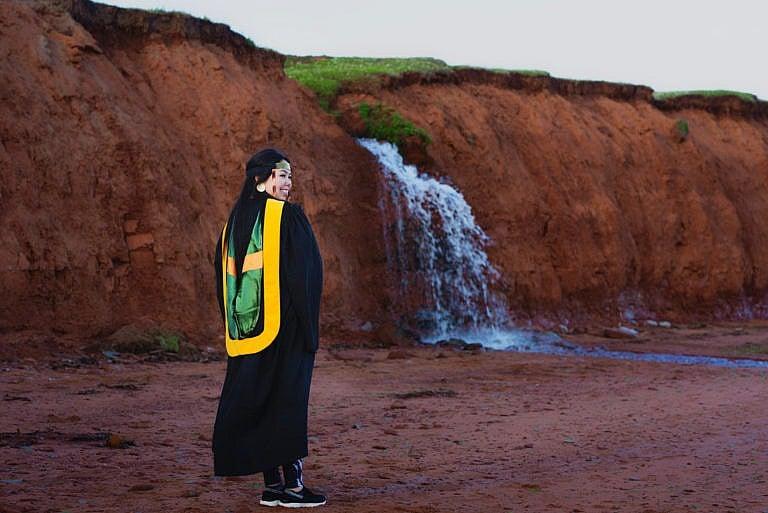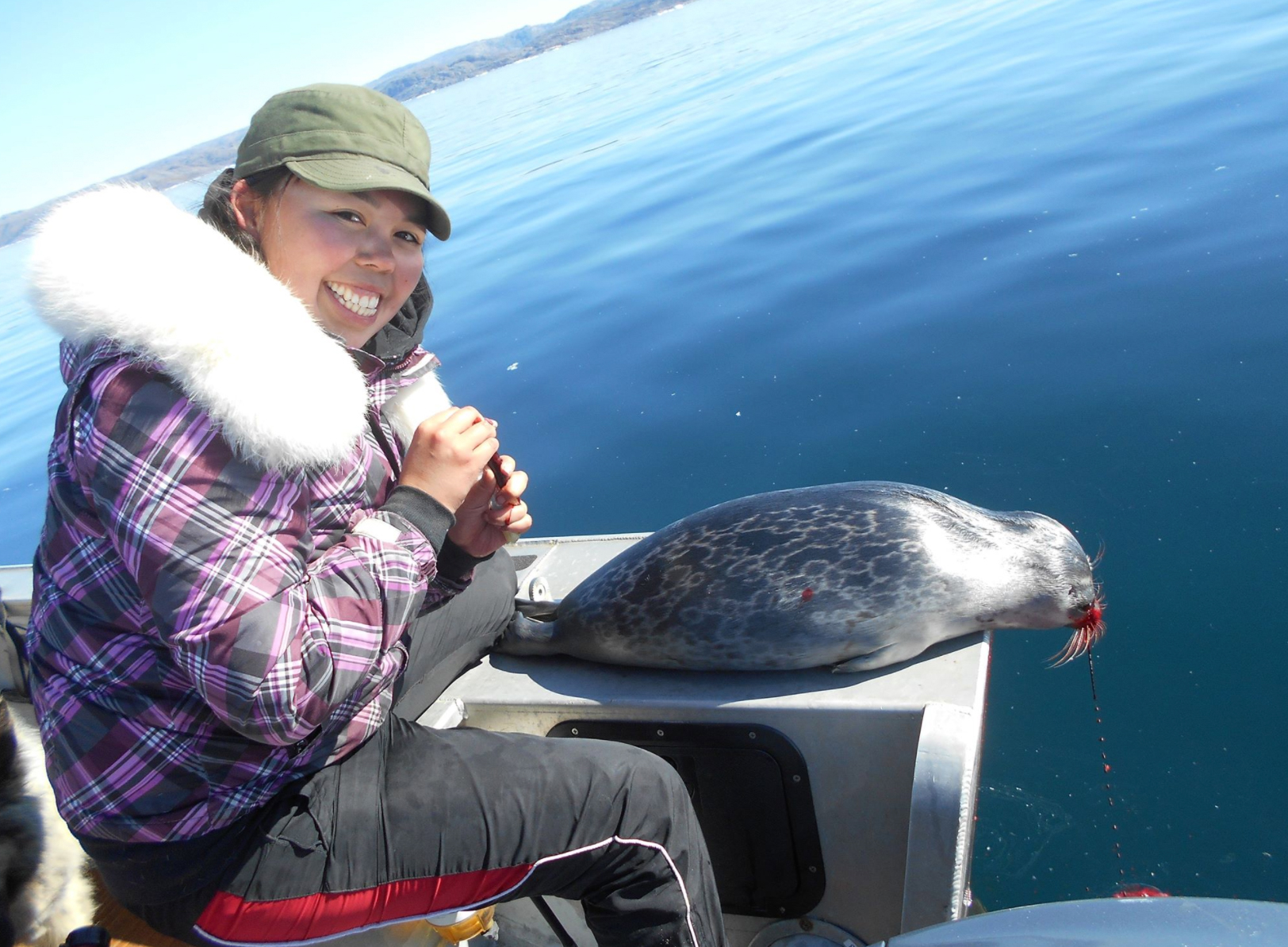Using traditional Inuit knowledge and Western science to study Arctic marine life
Since leaving Nunavut to study marine biology at the University of Guelph, Ph.D. student Enooyaq Sudlovenick has sought to understand more about the life that roams below the Arctic’s ocean surface

Sudlovenick wrote her master’s thesis on Iqaluit’s ringed seals (Patricia Bourque)
Share
Growing up on Baffin Island, Enooyaq Sudlovenick often ventured out on the water with her parents, leaning off the side of their boat to scoop up and marvel at schools of sea angels. When ocean levels dipped, she would search shallow tidal pools for eels and northern krill. Year-round, she also participated in Inuit hunting, harvesting and fishing traditions. All of this, she says, opened her eyes to an abundant aquatic ecosystem that has sustained her community for millennia.
“The Arctic is not as barren as people think. It’s rich with life,” she says. “Being on the water, it feels like home. It’s calm, it’s peaceful and familiar. But there is still so much we still don’t know.”
Since leaving the North to go to university, the Nunavut-born student has sought to understand more about the life that roams below the region’s ocean surface. Her post-secondary journey began in 2013 at the University of Guelph, where she earned a bachelor of science in marine and freshwater biology. She then enrolled at the University of Prince Edward Island, where she wrote her thesis on Iqaluit’s ringed seals and graduated with a master’s of science in veterinary medicine, pathology and microbiology.
READ: Inside Nunavut Sivuniksavut, a unique post-secondary option for Inuit youth
These days, she serves as president of the ArcticNet Student Association while completing a Ph.D. at the University of Manitoba. Her research compares and assesses the health of beluga whales in western Hudson Bay and the eastern Beaufort Sea, while attempting to understand how their health can be better characterized. Her work has received national recognition; she is the 2021 recipient of the Weston Family Award in Northern Research.
Sudlovenick uses both Western science and traditional Inuit knowledge in her research. Using a scientific lens, she might look at trends in bacteria, contaminants, pathogens and gene biomarkers present in parts of the whale. At the same time, she consults with local Inuit about their whale observations, such as differences in taste, physical appearance, or changes in birth or migration rates over time. She interviews hunters, Elders and other Inuit who process the animals to hear their observations and concerns and understand how they monitor the health of regional whale populations. The participation of locals also makes field days run smoother. For example, when Sudlovenick collects samples of beluga skin, blubber, blood, muscles and organs, she does it with hunters who are skilled in harpooning whales.
The Arctic region is warming, so she says it is important to monitor and gain a thorough understanding of how wildlife and nutritional Inuit staples like beluga are affected.
“This is work that hits me on a very personal level. I have a foot in both worlds, but I’m eating these whales, too,” she says. “Access to country food nourishes your body, your spirit, your everything. It’s like soul food. It’s very important for us.”

Academics, environmentalists and Indigenous organizations are calling for more Indigenous-led research that includes traditional knowledge, not only as a step toward reconciliation but also to strengthen solutions in the face of climate change. Lisa Loseto, Sudlovenick’s Ph.D. supervisor and an associate professor of environment and geography at the University of Manitoba, has seen scientific research in the Arctic slowly evolve to incorporate the expertise of Inuit populations over the past two decades, but says there is a need for more collaborative research, like Sudlovenick’s.
“The North is the canary in the coal mine,” Loseto says. “There’s change being observed so fast there, and we need to listen up.”
Loseto is certain that Sudlovenick will help advance the current trajectory in natural sciences that places value on Indigenous knowledge. “I respect her for standing in the middle of complex and uncomfortable places,” Loseto says. “Being the only Inuit person representing an organization of southern people doing work in her backyard, but encouraging people to be better at it and then speaking to people in her backyard to say ‘trust us’—she’s very brave.”
RELATED: Arctic narwhals have a new enemy: the noise of passing ships
For decades, scientists from southern regions have flown into the North to do their work and then left, failing to consult or work with locals, or using their findings to solely benefit themselves and their institutions. Inuit Tapiriit Kanatami, the national organization representing Inuit in Canada, released its National Inuit Strategy on Research in 2018 to encourage changed approaches in the North. The plan advocates for more Inuit-led work and increased local participation in research projects. According to Natan Obed, the organization’s president, a more collaborative approach will help repair relationships and influence effective policy decisions, including adaptations to climate change.
“Having researchers like Enooyaq, it shows that we are capable, and that the outcomes of this will be beneficial to our communities in a way that is more nuanced than ever before,” Obed says. “There are very few [researchers] who have ever been able to connect on a familial level, on a community level, and also who live and have family in communities where the research takes place. All of this matters, and it also matters from a perspective of seeing what’s possible.”
Sudlovenick, meanwhile, says she plans to complete her Ph.D. within the next two years and hopes to move back to the North and work within her community. As she looks to wrap up her student journey, she has a message for those interested in university sciences, particularly Indigenous youth: “It looks daunting sometimes, but there’s so much support, so much space and so much opportunity to do good. Just go for it.”
This article appears in print in the 2022 University Rankings issue of Maclean’s magazine with the headline, “How to get close to the seals and whales.”